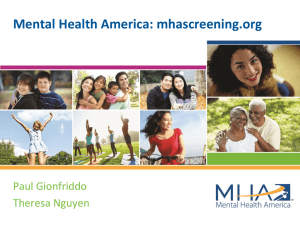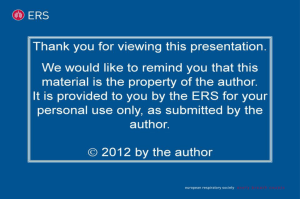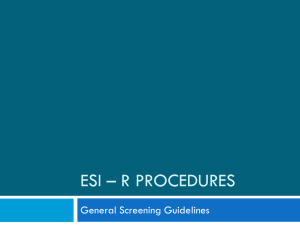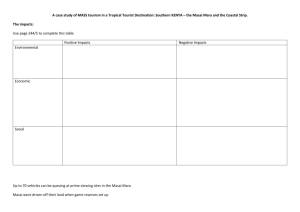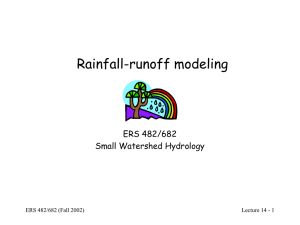PowerPoint
advertisement
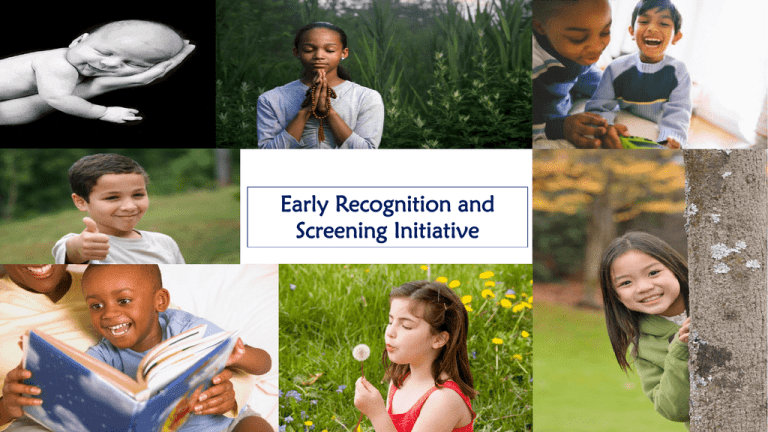
Early Recognition and Screening Initiative Social and emotional development colors every aspect of a child's life and sets the stage for a strong foundation for later development. Childhood mental health is important for the social, emotional, and behavioral well-being of children, including their capacity to: Experience and express a wide range of emotion Form close, secure relationships with family and caregivers Explore their environment and learn. Snapshot of Child and Adolescent Mental Health Trends • 1 out of 10 children have a serious emotional disturbance. 20 percent of youth (14 million) in the United States suffer from mental illness severe enough to cause some level of impairment.(1) • Only 20% of those with an emotional disturbance receive treatment. • Half of all chronic mental illness begins by age 14.(3) (2) Children with Emotional Issues – Impact on Education • The expulsion rate among children in prekindergarten programs is more than three times the rate for K-12 students (4) • Nearly all children with severe mental illness have experienced erratic academic programming due to their cyclical psychiatric crises and frequent changes in their learning environment. • Emotional disturbance is associated with the highest rate of school dropout among all disability groups. Approximately 50% of students age 14 and older who are living with a mental illness drop out of high.(5) • By high school few young people have a future vision that drives engagement in school or vocational pursuits. • Suicide is the third leading cause of death in youth ages 15 to 24. More teenagers and young adults die from suicide than from cancer, heart disease, AIDS, birth defects, stroke, pneumonia, influenza and chronic lung disease combined) (6) • 50% of children and youth in the child welfare system have been assessed as having mental health problems (7) • Between 67-75% of kids in juvenile justice settings are diagnosed as having a mental illness (8) Scientific Imperatives • There is a long and rich scientific history substantiating the fact that there is a developmental progression to behavioral/emotional problems among young children • Kessler et al shows that the age of onset for serious mental illness in adulthood occurs in early adolescence, yet identification and treatment are often delayed for years. (9) • Emotional or behavioral problems unrecognized in childhood can cascade into full blown psychiatric disorders with serious debilitating consequences in adolescence or adulthood Achieving the Promise – A New Way of Serving Children and Families Research shows - if we identify and intervene early, we are more likely to: • Decrease interference with emotional, intellectual, or physical development • Prevent issues from lasting a long time or getting worse • Improve school performance and personal relationships with family and friends Early intervention also leads to an improved learning environment in the school and increased family support NYS Children’s Plan • Since the development of The Children’s Plan in 2008, the DCF has developed initiatives that help establish supports for young children’s social emotional development across a wide range of settings (10) • Early identification and intervention have framed our efforts as we focus on promoting positive social emotional development, providing social emotional well being screening and linkages to services and supports and prevention efforts that provide evidence based parent training. Early Recognition Coordination and Screening Initiative Supports the early identification of social emotional difficulties by funding full time Early Recognition Specialists who are responsible for creating a comprehensive plan for early identification, engagement, outreach, and stigma reduction in their community. ERS Components • Conduct, coordinate and/or oversee all screening activity within a designated area • Promote social emotional wellness throughout the community • Network with parents, primary care physicians and other community leaders • Provide education to increase community awareness of social and emotional development • Participate in existing child-serving agency networks, or facilitate the creation of new or stronger networks, and utilize those networks to continually evaluate for the need to target and screen particular populations Screening Component • In natural settings like schools, health centers, and other community locations to reach children early who may have emotional needs • Age of children screened varies – Can be from age 0-21 • Screens used are chosen by age of child and location Screens Used • Ages and Stage – Social Emotional • Pediatric Symptom Checklist 17 or 35 • Deveraux Early Childhood Assessment Screening Process • Parental consent required for children and teens under the age of 18 • Screens may be completed by or with the ERS Specialist or by parent or child and collected in the location where it is provided • Completed screens are collected and scored by ERS Specialist • Follow up by ERS specialist with the family Progress to Date: As of December 31, 2013: Over 87,800 screens have been completed in children and youth ages 0-21 Screens completed in doctor offices have increased throughout the initiative. This trend is congruent with the goal to cultivate relationships with primary care offices to promote and screen for behavioral health concerns and to advance the understanding that routine checkups for social emotional development are just as important as checking a child’s height and weight. ERS Screens by Location/Quarter 60% 50% 40% 30% 20% 10% 0% Q1 2012 Q2 2012 Q3 2012 Q4 2012 Q1 2013 Schools Early Childhood Foster Care Juvenile Justice Preventive Services Other Q2 2013 Q3 2013 Pediatrician Q4 2013 Progress to Date: • The largest number of screens has been completed in the “4 to 6 year old” age and the second largest number of completed screens is in the “7 to 9 year old” age group. The high number of screens completed in these age groups advances the objective of earlier identification of social emotional difficulties so that they can be more easily addressed. ERS Screens by Age/Quarter 40% 35% 30% 25% 20% 15% 10% 5% 0% Q1 2012 Q2 2012 Q3 2012 Q4 2012 Q1 2013 Q2 2013 0 to 3 years 4 to 6 years 7 to 9 years 13 to 15 years 16 to 18 years Unknown Q3 2013 10 to 12 years Q4 2013 Promotion of Social Emotional Wellness • Participation in Awareness events, wellness fairs and community celebrations • Educational Presentations for parents and the community • Trainings for staff within early childhood centers, schools, primary care offices National Children's Mental Health Awareness Day 2014 In 2014, National Children's Mental Health Awareness Day is May 8. The national launch event for Awareness Day 2014 takes place on May 6 in conjunction with the National Council for Behavioral Health's annual conference in Washington, DC. The launch event will focus on the unique needs of young adults, ages 16–25, with mental health challenges and the value of peer support in helping young adults build resilience in the four life domains of housing, education, employment and health care access. Awareness Day seeks to raise awareness about the importance of children's mental health and that positive mental health is essential to a child's healthy development from birth. Communities around the country participate by holding their own Awareness Day events, focusing either on the national theme, or adapting the theme to the populations they serve. http://www.samhsa.gov/children/national.asp http://www.samhsa.gov/children/ “So how are the children?” Kasserian Ingera? "Among the tribes of Africa, few have warriors traditionally more fearsome or more cunning than the Masai of Kenya. It is perhaps surprising, then, to learn the traditional greeting among Masai warriors. One warrior would always say to another, “Kasserian Ingera,” which, in Swahili, means, “Are the children well?” It is still the traditional greeting among the Masai, acknowledging the high value of the Masai for the well-being of children. Even modern Masai with no children of their own always give the traditional answer, “All the children are well,” meaning, of course, that peace and safety prevail – that the priorities of protecting the young and powerless are in place, that Masai society has not forgotten its reason for being and its responsibilities. “All the children are well” means that life is good. It means that the daily struggles of existence do not preclude proper care for the young. Rebecca LaBarge, ERS Northeast Parent & Child Society Child Guidance Community Partners • • • • • • Boys and Girls Club Early Head Start SCAP Head Start Schenectady School District Pooh’s Corner Hometown Health Merge with Primary Care • OMH Co-location Grant • Provide screen during annual visits • Co-located therapist • Barriers Lisa Brate, ERS Parsons Child Guidance Clinic Provide Ages & Stages Questionnaire to: • Cohoes City School District • Ballston Spa School District • Select Child Care centers • Albany County Healthy Families Provide the Pediatric Symptom Checklist (PSC) to: • Albany City Schools • Community Out-Reach Events Review the Devereux Early Childhood Assessment (DECA) • Albany Head Start and Early Start Programs Intake for the 0-5 population for the Guidance Clinic What Role is there for School Nurses and other school personnel • Advocate for Screening within schools • Assist in Providing Support and Information to Parents • Encourage ERS participation in general health and wellness events • Assistance in obtaining space for screening • Provide School Programs that promote social emotional wellness and address Stigma associated with mental health issues • Enlist support of PTA, SEPTA and other parent groups • Enlist support of student groups SOURCES New Freedom Commission on Mental Health. (2003). Achieving the promise: Transforming mental health care in America. Final report 2. “National Action Agenda for Children’s Mental Health: Report of the Surgeon General”, January 2001 1. 3. National Institute of Mental Health Release of landmark and collaborative study conducted by Harvard University, the University of Michigan and the NIMH Intramural Research Program (release dated June 6, 2005 and accessed at www.nimh.nih.gov). 4. Gilliam, W. S. (2005). Prekindergartens left behind: Expulsion rates in state prekindergarten programs (FCD Policy Brief Series 3). New York, NY: Foundation for Child Development. 5. U.S. Department of Education, Twenty-third annual report to Congress on the implementation of the Individuals with Disabilities Education Act, Washington, D.C., 2001 6. National Strategy for Suicide Prevention: Goals and Objectives for Action. Rockville, MD: U.S. Dept. of Health and Human Services, Public Health Service, 2001.CDC, 2001 7. Burns, B.; Phillips, S.; Wagner, H.; Barth, R.; Kolko, D.; Campbell, Y.; & Yandsverk, J. (2004). Mental health need and access to mental health services by youths involved with child welfare: A national survey. Journal of the American Academy of Child and Adolescent Psychiatry, 43(8), pp. 960-970. 8. Skowyra, K. R. & Cocozza, J. J. (2006). Blueprint for change: A comprehensive model for the identification and treatment of youth with mental health needs in contact with the j juvenile justice system. Delmar, NY: The National Center for Mental Health (NCMHJJ) and Policy Research Associates, Inc. <www.ncmhjj.com/Blueprint/pdfs/Blueprint.pdf>. 9. Kessler, R. C.; Beglund, P.; Demler, O.; Jin, R.; & Walters, E. E. (2005). Lifetime prevalence and the age-of-onset distributions of DSM-IV disorders in the National Comorbidity Survey Replication. Archives of General Psychiatry, 62(6), pp. 593-602. 10. http://ccf.ny.gov/files/5013/7962/7099/childrens_plan.pdfSkowyra, K. R. & Cocozza, J. J. (2006). Blueprint for change: A comprehensive model for the identification and treatment of youth with mental health needs in contact with the juvenile justice system. Delmar, NY: The National Center for Mental Health (NCMHJJ) and Policy Research Associates, Inc. <www.ncmhjj.com/Blueprint/pdfs/Blueprint.pdf>.
